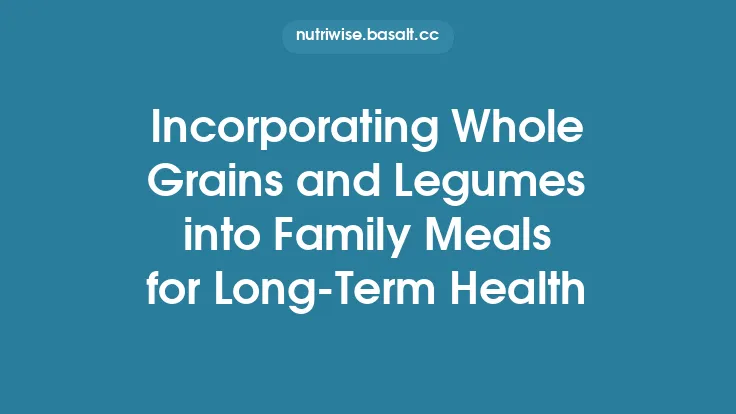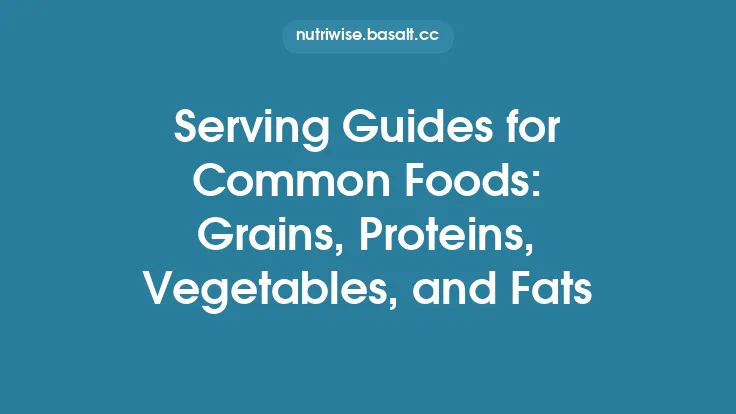Combining legumes and grains is one of the most reliable ways to obtain all essential amino acids from a plant‑based diet without relying on animal products or highly processed protein isolates. While each food group on its own provides a valuable source of protein, they differ in the specific amino acids they supply in abundance. By pairing them thoughtfully, you can create meals that deliver a “complete” protein profile—meaning they contain sufficient quantities of the nine essential amino acids that the human body cannot synthesize on its own. This approach has been used for centuries across cultures, and it aligns perfectly with the principles of sustainable and ethical eating: it maximizes nutritional value while minimizing environmental impact.
Why Complementary Proteins Matter
Proteins are built from 20 different amino acids, nine of which are essential. When a single food source lacks adequate amounts of one or more of these essential amino acids, it is termed “incomplete.” Most plant proteins fall into this category, but the deficiency is usually predictable. Legumes (beans, lentils, peas, chickpeas) are typically low in the sulfur‑containing amino acids methionine and cysteine, yet they are rich in lysine. Grains (rice, wheat, barley, corn, millet) display the opposite pattern: they are relatively high in methionine and cysteine but low in lysine.
If you consume only legumes, you may meet or exceed your lysine needs but fall short on methionine. Conversely, a grain‑only diet may provide enough methionine but insufficient lysine. By eating both in the same meal—or at least within the same day—the limiting amino acid in one food is compensated for by the other, resulting in a protein source that meets the body’s requirements.
The Science of Amino Acid Complementarity
The concept of complementarity is rooted in the “limiting amino acid” principle. When the body digests protein, it breaks it down into its constituent amino acids, which are then reassembled into new proteins as needed. If any essential amino acid is present in insufficient quantity, protein synthesis stalls, and the excess of other amino acids is oxidized for energy rather than used for growth or repair.
A simplified illustration:
| Food Group | High in | Low in |
|---|---|---|
| Legumes | Lysine, Threonine, Leucine | Methionine, Cysteine, Tryptophan |
| Grains | Methionine, Cysteine, Tryptophan | Lysine, Threonine, Leucine |
When you combine a legume with a grain, the high‑lysine legume supplies the lysine that the grain lacks, while the grain supplies the methionine that the legume lacks. The net result is a protein mixture whose essential amino acid profile approximates that of animal proteins, often reaching a Protein Digestibility‑Corrected Amino Acid Score (PDCAAS) of 0.8–0.9, comparable to dairy or eggs.
Choosing the Right Legume–Grain Pairings
Not all legumes and grains pair equally well, and the culinary context can influence both taste and nutrient absorption. Below are some classic and nutritionally sound combinations:
| Legume | Grain | Reason for Pairing |
|---|---|---|
| Black beans | Brown rice | Balanced lysine/methionine; widely used in Latin American cuisine |
| Chickpeas | Bulgur wheat | Complementary amino acids; bulgur’s quick cooking time suits salads |
| Lentils | Barley | Lentils provide lysine; barley adds methionine and soluble fiber |
| Split peas | Millet | Peas are lysine‑rich; millet supplies methionine and a mild flavor |
| Kidney beans | Cornmeal (polenta) | Corn is low in lysine; kidney beans compensate, creating a hearty stew base |
| Soy‑free edamame (if avoiding soy) | Quinoa is excluded per scope; instead use whole‑grain oats for breakfast bowls |
When selecting pairings, consider the following criteria:
- Amino Acid Balance – Aim for a legume that is high in lysine paired with a grain that is high in methionine.
- Culinary Compatibility – Flavor, texture, and cooking time should complement each other.
- Nutrient Synergy – Some grains contain phytates that can inhibit mineral absorption; pairing with legumes that are soaked or sprouted can mitigate this effect.
Practical Ratios and Portion Guidance
The exact ratio needed to achieve a complete protein can vary based on the specific foods and individual protein requirements. However, research and traditional dietary patterns suggest a simple rule of thumb:
- 1 part legume to 2 parts grain (by weight)
For example, 100 g cooked lentils (≈9 g protein) combined with 200 g cooked brown rice (≈5 g protein) yields roughly 14 g of protein with a balanced essential amino acid profile. This 1:2 ratio works well for most adult needs when meals are consumed multiple times per day.
If you prefer a grain‑dominant dish (e.g., a rice pilaf), you can increase the grain proportion to 3 parts grain to 1 part legume, provided you include another legume‑rich meal later in the day. The key is that the total daily intake of lysine and methionine meets the recommended dietary allowance (RDA): roughly 38 mg/kg body weight for lysine and 19 mg/kg for methionine in adults.
Cooking Techniques that Preserve Protein Quality
- Soaking and Sprouting – Soaking beans for 8–12 hours (or overnight) reduces antinutrients such as phytic acid and oligosaccharides, improving protein digestibility and reducing gas formation. Sprouting for 2–3 days further increases the availability of lysine and other amino acids.
- Gentle Boiling – Over‑cooking can cause Maillard reactions that bind amino acids to sugars, making them less bioavailable. Aim for a tender‑but‑firm texture; most legumes are done when a fork slides in with slight resistance.
- Steaming Grains – Steaming rather than boiling can preserve B‑vitamins and prevent leaching of water‑soluble amino acids.
- Combining During Cooking – Cooking legumes and grains together (e.g., a one‑pot bean‑and‑rice dish) can reduce cooking time and allow the flavors to meld, but be mindful of differing water absorption rates. Pre‑cook the legume partially before adding the grain.
- Acidic Additions – Adding a splash of lemon juice or a modest amount of tomato sauce at the end of cooking can improve iron absorption from legumes, which is especially valuable when the meal is the primary protein source.
Cultural Traditions that Exemplify the Combination
Across the globe, traditional cuisines have long recognized the nutritional synergy of legumes and grains:
- Latin America: *Arroz con frijoles* (rice and black beans) is a staple in Mexico, Central America, and the Caribbean. The dish provides a complete protein, fiber, and a range of micronutrients.
- West Africa: *Jollof rice with beans or waakye* (rice and black-eyed peas) combines fermented millet or sorghum with beans, enhancing both flavor and protein quality.
- Middle East: *Mujadara* (lentils and bulgur) offers a comforting, protein‑rich meal that also supplies iron and B‑vitamins.
- South Asia: *Khichdi* (rice and split mung beans) is often served as a light, easily digestible dish, especially during convalescence.
- East Asia: *Mixed grain porridge* with soy‑free adzuki beans (though adzuki is a legume, the grain component can be barley or millet) provides a balanced protein source for breakfast.
These dishes illustrate that the legume–grain pairing is not a modern invention but a time‑tested strategy for nutritional adequacy.
Meal Planning Strategies for Daily Balance
- Breakfast: Start the day with a warm grain porridge (e.g., oatmeal) topped with a spoonful of cooked lentils or a side of bean‑based spread. The combination supplies protein early, stabilizing blood sugar.
- Lunch: Build a bowl with a base of quinoa‑free whole grain (brown rice, barley, or millet) and a generous portion of mixed beans. Add vegetables, a drizzle of olive oil, and a squeeze of citrus for micronutrient boost.
- Snack: Prepare hummus (chickpeas) with whole‑grain crackers or roasted corn tortillas. This mini‑meal offers a quick protein hit.
- Dinner: Create a one‑pot stew of barley, kidney beans, tomatoes, and herbs. Serve with a side of sautéed greens to round out the meal with calcium and vitamin K.
- Evening Option: A small serving of rice pudding made with coconut milk and a swirl of black‑bean puree can satisfy sweet cravings while delivering protein.
By distributing legume–grain combos across meals, you avoid the need for large single‑serving portions and keep digestion comfortable.
Addressing Common Concerns: Anti‑Nutrients and Digestibility
Phytic Acid: Present in both legumes and grains, phytic acid can bind minerals like iron, zinc, and calcium. Soaking, sprouting, and cooking significantly reduce its concentration. Pairing with vitamin C‑rich foods (e.g., bell peppers, citrus) further enhances mineral absorption.
Oligosaccharides (Raffinose, Stachyose): These cause flatulence in some individuals. Soaking and discarding the soaking water, followed by thorough cooking, mitigates the effect. Introducing fermented legume products (e.g., tempeh‑free fermented beans) can also break down these sugars.
Protein Digestibility: The Protein Digestibility‑Corrected Amino Acid Score (PDCAAS) for most cooked legume–grain combos ranges from 0.75 to 0.90, indicating high bioavailability. Adding a small amount of healthy fat (olive oil, avocado) can improve the absorption of fat‑soluble vitamins that accompany the protein.
Storage and Shelf‑Life Considerations
- Dry Legumes: Store in airtight containers in a cool, dark pantry. Most beans retain quality for 1–2 years; lentils and split peas can last up to 3 years.
- Whole Grains: Keep in sealed jars or vacuum‑packed bags. Whole‑grain rice, barley, and millet stay fresh for 12–18 months; once cooked, refrigerate within 2 hours and consume within 4 days, or freeze for up to 3 months.
- Cooked Combinations: Portion cooked legume–grain mixes into single‑serve containers. This not only simplifies meal prep but also reduces repeated heating, which can degrade some heat‑sensitive nutrients.
Putting It All Together: Sample Menus
| Meal | Components | Approx. Protein |
|---|---|---|
| Breakfast | Warm millet porridge (½ cup cooked) + ¼ cup cooked red lentils, topped with chopped nuts and a dash of cinnamon | 12 g |
| Mid‑Morning Snack | Whole‑grain rye crackers (4 pcs) + 2 Tbsp black‑bean dip | 8 g |
| Lunch | Brown rice (1 cup) + mixed bean salad (½ cup chickpeas, ½ cup kidney beans) with diced tomatoes, cilantro, lime | 20 g |
| Afternoon Snack | Small bowl of oat‑based granola (½ cup) with a spoonful of cooked split pea puree | 7 g |
| Dinner | Barley pilaf (¾ cup) with sautéed green lentils (½ cup), roasted carrots, and a drizzle of tahini | 18 g |
| Total Daily Protein | — | ≈ 65 g (well within the RDA for most adults) |
These menus demonstrate how a variety of legume–grain pairings can be woven into everyday eating without relying on soy, quinoa, or specialized protein powders. The approach is flexible, culturally adaptable, and aligns with sustainable food systems by emphasizing whole, minimally processed plant foods.
By understanding the complementary nature of legumes and grains, selecting appropriate pairings, and applying simple cooking and storage techniques, anyone can build a nutritionally complete, plant‑based diet that supports health, respects the planet, and honors culinary traditions. The result is a resilient eating pattern that delivers all essential amino acids, abundant fiber, and a spectrum of micronutrients—proving that sustainable, ethical eating can be both delicious and scientifically sound.





